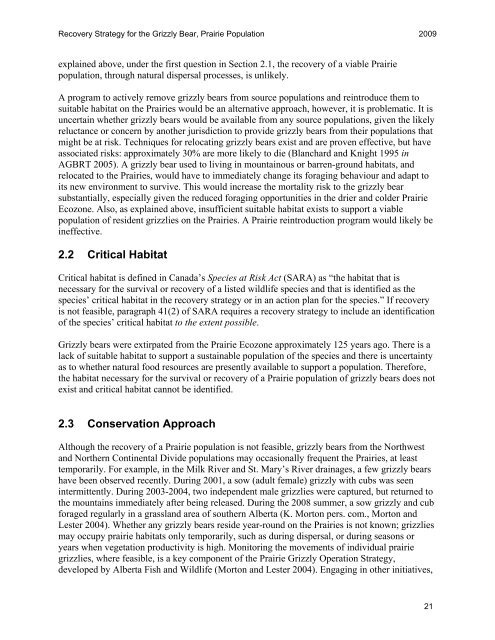Grizzly Bear (Ursus arctos), Prairie Population - Publications du ...
Grizzly Bear (Ursus arctos), Prairie Population - Publications du ...
Grizzly Bear (Ursus arctos), Prairie Population - Publications du ...
Create successful ePaper yourself
Turn your PDF publications into a flip-book with our unique Google optimized e-Paper software.
Recovery Strategy for the <strong>Grizzly</strong> <strong>Bear</strong>, <strong>Prairie</strong> <strong>Population</strong> 2009<br />
explained above, under the first question in Section 2.1, the recovery of a viable <strong>Prairie</strong><br />
population, through natural dispersal processes, is unlikely.<br />
A program to actively remove grizzly bears from source populations and reintro<strong>du</strong>ce them to<br />
suitable habitat on the <strong>Prairie</strong>s would be an alternative approach, however, it is problematic. It is<br />
uncertain whether grizzly bears would be available from any source populations, given the likely<br />
reluctance or concern by another jurisdiction to provide grizzly bears from their populations that<br />
might be at risk. Techniques for relocating grizzly bears exist and are proven effective, but have<br />
associated risks: approximately 30% are more likely to die (Blanchard and Knight 1995 in<br />
AGBRT 2005). A grizzly bear used to living in mountainous or barren-ground habitats, and<br />
relocated to the <strong>Prairie</strong>s, would have to immediately change its foraging behaviour and adapt to<br />
its new environment to survive. This would increase the mortality risk to the grizzly bear<br />
substantially, especially given the re<strong>du</strong>ced foraging opportunities in the drier and colder <strong>Prairie</strong><br />
Ecozone. Also, as explained above, insufficient suitable habitat exists to support a viable<br />
population of resident grizzlies on the <strong>Prairie</strong>s. A <strong>Prairie</strong> reintro<strong>du</strong>ction program would likely be<br />
ineffective.<br />
2.2 Critical Habitat<br />
Critical habitat is defined in Canada’s Species at Risk Act (SARA) as “the habitat that is<br />
necessary for the survival or recovery of a listed wildlife species and that is identified as the<br />
species’ critical habitat in the recovery strategy or in an action plan for the species.” If recovery<br />
is not feasible, paragraph 41(2) of SARA requires a recovery strategy to include an identification<br />
of the species’ critical habitat to the extent possible.<br />
<strong>Grizzly</strong> bears were extirpated from the <strong>Prairie</strong> Ecozone approximately 125 years ago. There is a<br />
lack of suitable habitat to support a sustainable population of the species and there is uncertainty<br />
as to whether natural food resources are presently available to support a population. Therefore,<br />
the habitat necessary for the survival or recovery of a <strong>Prairie</strong> population of grizzly bears does not<br />
exist and critical habitat cannot be identified.<br />
2.3 Conservation Approach<br />
Although the recovery of a <strong>Prairie</strong> population is not feasible, grizzly bears from the Northwest<br />
and Northern Continental Divide populations may occasionally frequent the <strong>Prairie</strong>s, at least<br />
temporarily. For example, in the Milk River and St. Mary’s River drainages, a few grizzly bears<br />
have been observed recently. During 2001, a sow (a<strong>du</strong>lt female) grizzly with cubs was seen<br />
intermittently. During 2003-2004, two independent male grizzlies were captured, but returned to<br />
the mountains immediately after being released. During the 2008 summer, a sow grizzly and cub<br />
foraged regularly in a grassland area of southern Alberta (K. Morton pers. com., Morton and<br />
Lester 2004). Whether any grizzly bears reside year-round on the <strong>Prairie</strong>s is not known; grizzlies<br />
may occupy prairie habitats only temporarily, such as <strong>du</strong>ring dispersal, or <strong>du</strong>ring seasons or<br />
years when vegetation pro<strong>du</strong>ctivity is high. Monitoring the movements of indivi<strong>du</strong>al prairie<br />
grizzlies, where feasible, is a key component of the <strong>Prairie</strong> <strong>Grizzly</strong> Operation Strategy,<br />
developed by Alberta Fish and Wildlife (Morton and Lester 2004). Engaging in other initiatives,<br />
21

















